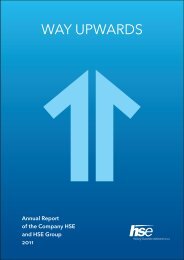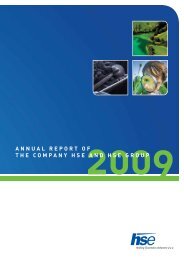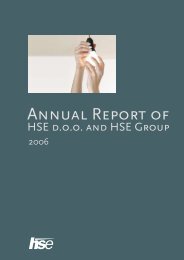WAY UPWARDS - HSE
WAY UPWARDS - HSE
WAY UPWARDS - HSE
Create successful ePaper yourself
Turn your PDF publications into a flip-book with our unique Google optimized e-Paper software.
Financial report of <strong>HSE</strong> Group<br />
177<br />
currency at the beginning of the period, which is repaired<br />
for the amount of effective interest and payments<br />
during the period, as well as amortised cost<br />
in foreign currency converted at the exchange rate at<br />
the end of the period. Non-cash assets and liabilities<br />
expressed in a foreign currency and measured at fair<br />
value are converted in the functional currency at the<br />
exchange rate on the date when the amount of fair<br />
value is determined. Foreign exchange differences<br />
are recognised in the consolidated income statement,<br />
namely according the net principle (difference<br />
between positive and negative foreign exchange differences<br />
among revenue or difference between negative<br />
and positive foreign exchange differences and<br />
expenses).<br />
In translation of financial statements of subsidiaries<br />
abroad, whose functional value is not equal to<br />
presentation value of the group, the following exchange<br />
rates are used:<br />
••<br />
Assets and liabilities »except equity« translated<br />
according to the exchange rate on the reporting<br />
date;<br />
••<br />
Equity according to historical exchange rate;<br />
••<br />
Revenue and expenses according to average<br />
exchange rate in the year of reporting.<br />
••<br />
Assessment of useful life of amortisable assets<br />
(Point 1, 2);<br />
••<br />
Test of impairment of assets (Disclosure 5.5.8.1. –<br />
Point 1, 2, 3, 4);<br />
••<br />
Assessment of fair value of derivatives (Disclosures<br />
5.5.8.8.3 and 5.5.8.8.4);<br />
••<br />
Assessment of realisable values of receivables;<br />
••<br />
Assessment of net realisable value of inventories;<br />
– Point 7);<br />
••<br />
Assessment of provisions for jubilee and<br />
termination benefits; – Point 13);<br />
••<br />
Assessment of other provisions (Disclosure 5.5.8.1.<br />
– Point 14); and<br />
••<br />
Assessment of contingent liabilities and assets<br />
(Disclosure 5.5.8.1. – Point 21).<br />
5.5.6 Branch and representative offices<br />
The company has two foreign branch offices in Czech<br />
Republic and Slovakia and two representative offices<br />
in Serbia and Romania. In 2011, the group companies<br />
did not perform transactions through subsidiaries.<br />
The operations of branch and representative offices<br />
are included in financial statements of the Group.<br />
5.5.5 Use of assessments and judgements<br />
The preparation of financial statements requires that<br />
the management forms certain assessments and assumptions<br />
which affect the disclosed amounts of<br />
assets and liabilities, revenue and expenses and disclosures<br />
of contingent assets and expenses in the reporting<br />
period.<br />
Assessments and judgements are based on past<br />
experience and other factors that are considered reasonable<br />
in the given circumstances and on the basis<br />
of which the judgements on the carrying amount of<br />
assets and liabilities are expressed. Since the assessments<br />
and assumptions are subject to subjective<br />
judgement and certain level of uncertainty, subsequent<br />
actual results can differ from assessments. The<br />
assessments are examined on regular basis. Changes<br />
in accounting estimates are recognised in the period<br />
in which the assessments were changed if the change<br />
affects only that period or in the period of change and<br />
in future periods in case the change affects future periods.<br />
Assessments and assumptions are present at least<br />
at the following judgements:<br />
5.5.7 Significant accounting policies<br />
The company’s financial statements are prepared on<br />
the basis of accounting policies presented below. The<br />
abovementioned accounting policies are used for all<br />
years presented, unless otherwise indicated.<br />
The comparative data was adopted when needed<br />
so that they are in accordance with the presentation of<br />
data in the current year.<br />
5.5.7.1 Basis for consolidation<br />
Consolidated financial statements comprise financial<br />
statements of the controlling company and subsidiaries.<br />
Subsidiaries are companies controlled by the<br />
Group. This means that the Group is able to decide on<br />
financial and business orientations of the company for<br />
obtaining benefits from its operations. Financial statements<br />
of subsidiaries are included in consolidated financial<br />
statements from the date when the controlling<br />
begins to the date when it stops.<br />
Transactions with the owners of non-controlling<br />
share are considered in a same way as transactions<br />
with external partners. Profits and losses of the owners
















